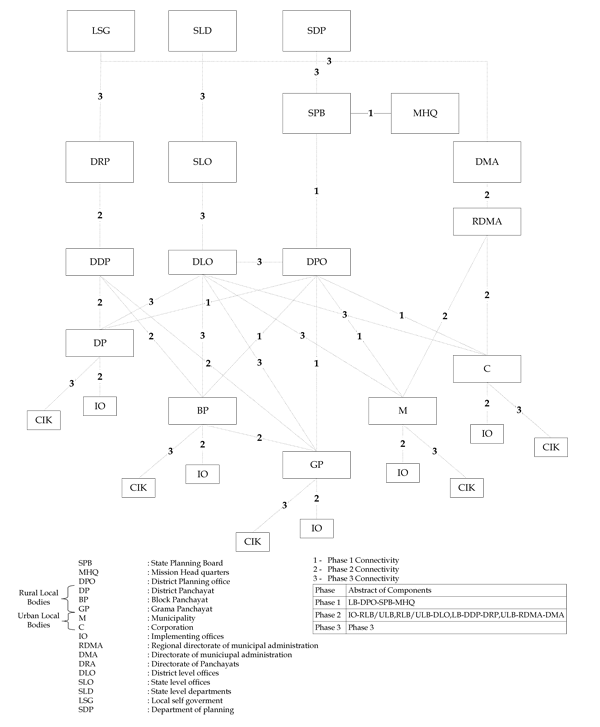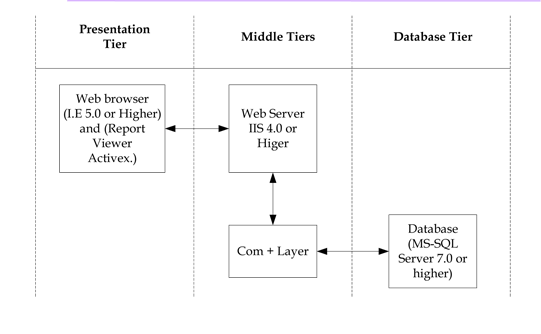Information Communication Technology (ICT) is rapidly gaining the center stage for future world economic growth and development. While ICT is gaining prominence as an engine for economic growth it also promises to have far reaching potential for the delivery of social services, enhancing the effectiveness of government administration. However to achieve improvement in services building up of community databases is critical in third world, where record keeping systems are deficient [Vongpanitlerd et.al, (1992)]. The task of recording all births, deaths and marriages have been entrusted with the local bodies in accordance with the registration of birth and death act, 1969 and the Hindu Marriage act, 1957. The system of registration at the local body offices is called civil registration to distinguish this from registration data collected through sample surveys called sample registration. The civil registration data can be used for generating vital statistics which shall be very useful in demographic and public health research on fertility, mortality etc.
The present civil registration system in most developing countries including India is incomplete and hence the sample registration is utilised in demographic studies. In the case of cause of death, details are not necessarily documented by the physician, even when filled up by medical practitioners the documentation is not often complete and even when the data is complete it is not analysed properly. There has not been serious efforts to popularise a coding scheme for the medical certification of cause of death in accordance with the guidelines issued by World Health Organisation (WHO) [Seal et. al. (1998),GOI(2001)].
Birth and death registration coverage levels in Kerala are the highest in the country, geographical coverage is very good and so is the accuracy of information, leaving aside the problems with recording causes of death. However marriages under the Hindu marriage act alone are presently registered in local bodies. Marriages of Christians, Muslims and citizens belonging to other religions are not covered. Similarly marriages under special marriage registration act also not covered. Full coverage systems are feasible in Kerala condition since an in depth network of local bodies is available for registration. A demographic surveillance system could easily be built up based on this.
Improving cause of death registration is feasible through an appropriate intervention among the medical community. To start with verbal autopsies can be carried out in the case of non-institutional death with efforts to improve institutional reporting as well. Apprehensions of medical personnel or complications arising out of accurate reporting has to be removed and public opinion built up to ensure proper reporting. Improving the documentation system through Sevana can be a major step in improving civil registration.
Another aspect covered by Sevana is the pensions and social welfare schemes. It was in the light of the seventy-third and seventy-fourth constitutional amendments endowing upon the Panchayat raj and municipality institutions the responsibility for preparation of plans and implementation of schemes for economic development and social justice that pensions and social welfare schemes handled by various departments was transferred to local bodies.
The details of pensions and social welfare schemes handled by local bodies are provided in table 1.
Table 1.Social welfare schemes handled by local bodies
| Sl No | Type | Name of Pension/ Schemes | Aspects of Beneficiary Profile |
| 1 | Pension | National Old Age Pension |
|
| 2 | Pension | Agriculture Labour Pension |
|
| 3 | Pension | Cigar Labour Pension |
|
| 4 | Pension | Physically Handicapped/Disability Pension |
|
| 5 | Pension | Moron Pension |
|
| 6 | Pension | Widow Pension |
|
| 7 | Pension | Unemployment Wages |
|
| 8 | Welfare Scheme | National Maternity Benefit scheme |
|
| 9 | Welfare Scheme | Balika Samridhi Yojana |
|
| 10 | Welfare Scheme | Financial Assistance to the Marriage of poor widow’s daughter |
|
| 11 | Welfare Scheme | Financial Assistance for thatching of house (SC/ST) |
|
| 12 | Welfare Scheme | Financial Assistance to the |
|
| 13 | Welfare Scheme | TA for SC/ST Candidates who are attending written tests / interview |
|
| 14 | Welfare Scheme | Medical Financial Assistance for SC/ST |
|
Materials and Methods
Sevana has excellent features for registration of birth, death and marriage, and provides for a very simple user interface for entry and generation of outputs. A scheme of standardisation of names and for more complete capture of addresses has also been attempted. Undertaking entry of past data on registration, facilities convenient handling of search in an electronic database, which improves the issue of birth, death and marriage certificates significantly. In the pilot computerisation exercise of IKM data on marriage, birth and death in five Grama panchayats has been recorded in computer. (See table 2 for the details of past records entered in various panchayats [IKM,(2001)]). In these panchayats the issue of certificates taken only 15 minutes in contrast with a normal delivery interval of 7 or more.
Table 2. Particulars of past records computerised by IKM in pilot Grama panchayats
| Name of Grama Panchayat | Birth Registration | Death Registration | Marriage Registration | |||
| Earliest year | No of records | Earliest year | No of records | Earliest year | No of records | |
| Amboori | 1979 | 2882 | 1979 | 1181 | 1984 | 156 |
| Kattakkada | 1970 | 8238 | 1970 | 4638 | 1980 | 2438 |
| Madavoor | 1970 | 2547 | 1970 | 2231 | 1970 | 2516 |
| Vellanad | 1970 | 4413 | 1970 | 3106 | 1970 | 1681 |
| Vilavoorkal | 1979 | 448 | 1979 | 1635 | 1979 | 387 |
In the case of pensions and social welfare schemes Sevana makes an attempt to improve administration and citizen service through one time capture of information on beneficiaries and providing means for updating it. This can improve speed of transactions and also eliminate scope for corruption. The important features of sevana application in handling pensions and social welfare schemes are provided in table 3
|
Sl No |
Feature |
Advantage |
|
1 |
Standardized interface for personal particulars |
Scope for an integrated service database (ISDB) |
|
2 |
Conversion date in of Malayalam calendar to Gregorian Calendar |
Facilitates entry of date of birth from old records in Malayalam Calendar. |
|
3 |
Graphic utility for entry of identification marks |
Standardisation of entries, more accurate and convenient entry based on visual inspection |
|
4 |
Option for entry of additional particulars like electoral indentification, ration card number, passport number, electricity consumer number, water connection number, BPL database etc. |
Can seamlessly integrate with other departmental database there by acquiring a pivotal role in handling community information |
|
5 |
Provision of masters and facility for standardized entry of names, addresses, occupational particulars, educational qualifications |
Better data capture and possibility for consolidation and analysis. |
|
6 |
Computerised generation of bills, money orders, acquaintance registers |
Speed of operation, more accurate documentation and reports and improvement of productivity. |
|
7 |
Management Information System (MIS) reports on citizenship and registration |
Process improvement in delivery of social welfare services and scope for evaluation of the beneficiary profile improving accountability and ensuring delivery to need worthy. |
|
8 |
MIS report on citizenship and civil registration |
Evaluation of build up of community databases and interventions for further improvements |
Currently registration and delivery of social welfare schemes and pensions2 in local bodies overlap. For effective analysis and consolidation networking of local bodies is therefore essential. The network architecture for IKM as shown in figure1 is suitable for this. Linkages with health department will facilitate on line reporting of institutional database on birth and death. Further departmental reporting on pensions and social welfare schemes becomes online and instantaneous. An additional network connection from the office of the Director of panchayats (Chief Registrar of Births and Death for the state) with the office of the Director of Bureau of Economics and Statistics (Additional chief Registrar of Birth’s and deaths for the state) would facilitate consolidation of information on civil registration and generation of vital statistics.
Looking into the broad requirements of application software development for the local bodies, arrived at based on a detailed system study taken by IKM, which also incorporates recommendations of the committee on decentralisation of powers, a technology choice was also arrived at [IKM (1999)]. The salient features of the technology choice3 shall be as shown in table 4. The design of Sevana shall fit in with the technology choice asoutlined above.
The application uses a four-tier architecture based on Active Server Pages (ASP) technology – the presentation tier, the middle tier and the database tier (See figure 2). The presentation layer consists of browser and report viewer ActiveX component which handles user interaction and client validation. The linkage of the presentation tier with the web server uses the ASP object model with five intrinsics.
Fig 1. Network Connections in IKM an evolutionary perspective.

| 1. | Hardware (Client and Server) | Intels’ Pentium based system |
| 2. | Operating System | Client : Microsoft’s Window NT Work Station 4.0 Server : Microsoft’s Windows NT Server 4.0/ Windows 2000 Server |
| 3. | Development Tool | Microsoft’s Visual Basic 6.0 and ASP for Web applications. |
| 4. | Database Server | Microsoft SQL Server 7.0/SQL Server 2000 |
| 5. | Web server | Microsoft’s Internet Information Server 4.0/Internet Information Server 5.0 |

Fig 3. Architecture of Sulekha
The client side validation is taken care of by client side scripting in Visual Basic script and Java script. Code running in the browser talks to the remote database through the remote scripting function of the web server, facilitating interactive downloading of the date conversion from Malayalam to Gregorian Calendar. The communication from ASP file in the web server to the database is using the ActiveX data objects in the com plus layer and is implemented of Microsoft API OLEDB4 with a data provider specific to MS-SQL. Microsoft Transaction Server (MTS) provides automatic transaction support to the scripting code executing within ASP files providing concurrency, security, resource pooling and transaction
processing.
Results and Discussion
The present system of civil registration in Kerala involves registration at local bodies, and transmission of the record of registration to the Bureau of Economics and Statistics where it is compiled using the Sevana application, online recording and compilation is possible, as and when the local body network to be established under the IKM programme comes into existence. The marriage registration mechanism is inadequate since registration occurs at several locations. The local body can persuade citizens to record marriage with it, provided a meaningful community database is available with it. The improvement in delivery of certificates is substantial and visible. This has turned out to be the most useful and visible demonstration of Information technology at the grass root level in the country. The present time for issue of 15 minutes can be further reduced once the transition from manual record keeping to electronic record keeping is completed fully, and the new systems stabilize. Once this is achieved the issue of certificates could be instantaneous and could be managed remotely from community Internet kiosks.
The scheme for integrated service database (ISDB) is useful and has improved the delivery of social welfare schemes. Consolidation of a list of probable list of beneficiaries in local bodies is essential because data entry in Malayalam is time consuming given the skills for data entry in Malayalam available presently. The citizen database concept, a one-time census survey of all citizens conducted along with the building tax assessment process can significantly improve the situation. Once integration of the ISDB with BPL is achieved it would be possible to see how effective the social welfare scheme coverage is, and the panchayat could possibly plan a social welfare net to cover the needy in a time bounded manner. Innovative schemes linked to insurance could also be thought of.
Conclusion
The ‘Sevana’ is the first high visibility and grass root level e-governance to be implemented in the country. The community databases linked to this could be every effectively used in planning interventions in the social sector in the state through local bodies as well as at the state level in long term.
References
- Government of India (2001). Annual Report – Ministry of Home affairs, Government of India.
- Information Kerala Mission (2001). Report on the status of record keeping on pensions, social welfare schemes and registration of birth, death and marriage and possible improvements through application of Information Technology. Information Kerala Mission, Thiruvananthapuram.
- Information Kerala Mission (1999). Information Kerala Mission – Technology Choice Document. Information Kerala Mission, Thiruvananthapuram.
- Unnikrishnan P V and Sreedharam E M (2001). Information Communication Technologies: Towards an alternative Policy Framework for Implementation. Information Kerala Mission, Thiruvananthapuram.
- Vongpanitlerd Sumeth, Siamwalla Ammar and Sripaipan Chatri (1992). Public Services in Thailand: the role of Information Technology. TDRI Quarterly Review Vol.7 No.4
